TOTER 2 SAIL Version
The
sailing version of TOTER 2 is complete, tested and the plans are now
available. This adaptation brings with it some surprises and some words
of caution. Remember, this is a small flat bottomed boat, intended for
casual fair weather use. The sail rig employs a relatively short 10
foot mast, designed to keep the 'center of pressure' of the sail as low
to the hull as practical. This minimizes the possibility of a
knockdown. The
existing design does not utilize a keel or leeboard. However, to add
lateral safety buoyancy, optional sponsons can be fabricated and
attached (bolted) to the sides of the main hull. All this is outlined
completely in the plans, with sketches and photos. The surprises are the
ease of handling of the small craft in the water, the ability to be
easily transported, rigged and launched by a single individual, and the
relative comfort of the cockpit area for individuals under six feet
tall.
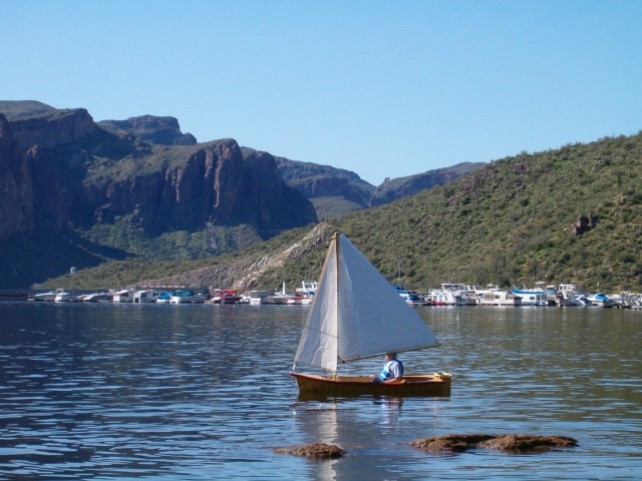
This photo was taken on a mild day with only light winds. Great for initial testing and fitting.
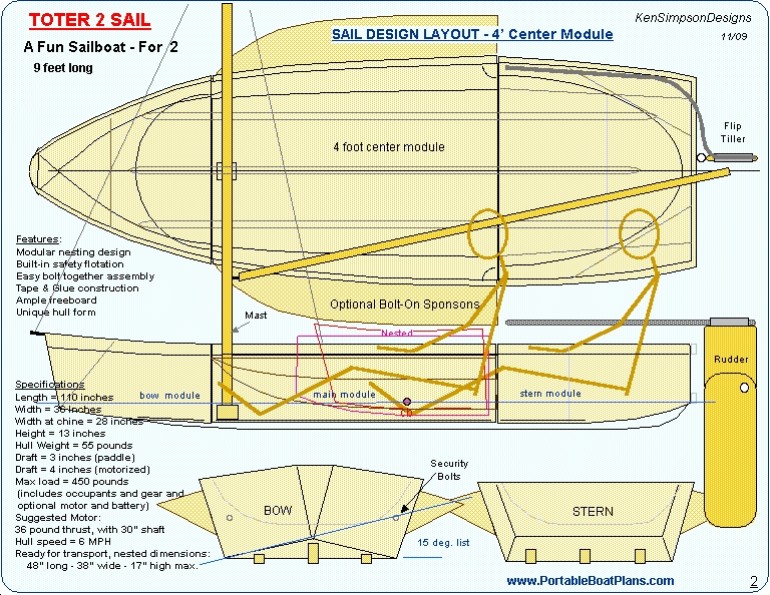
Assembly Photos
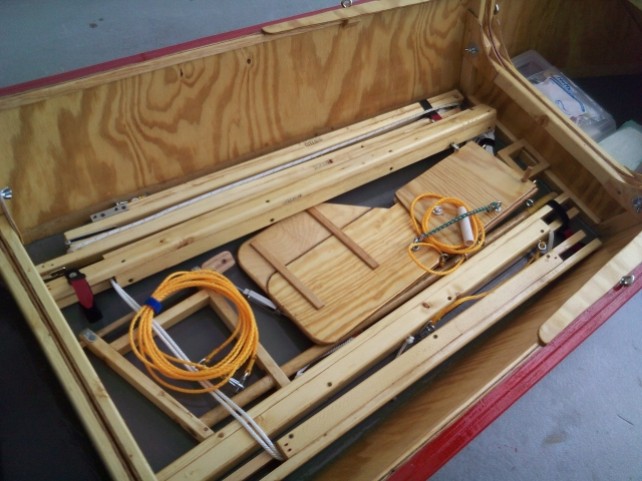
All Sail Rig Components fit in the Center Module for Transport.
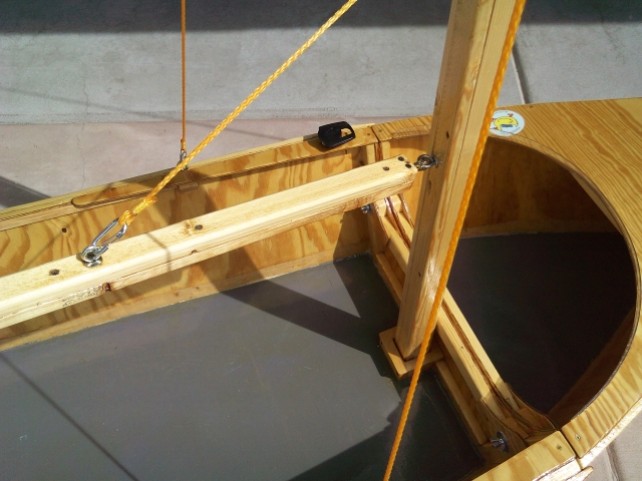
Initial setup of Mast and Boom, showing Mast Step and Attachment Locations.
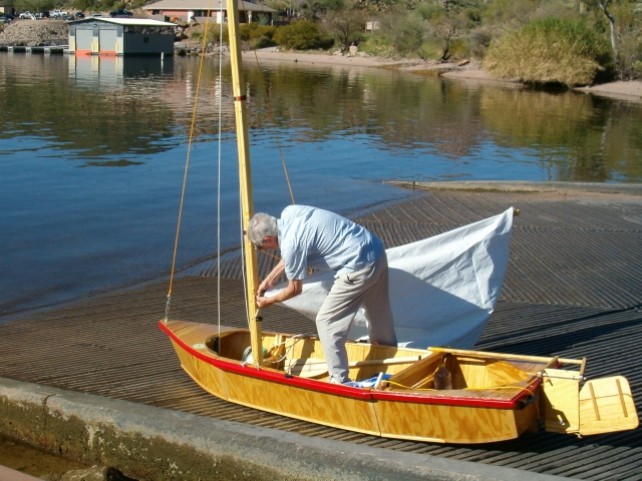
The designer/builder attaching the Mainsail to the Boom and Mast. Halyards run through the center of the mast.
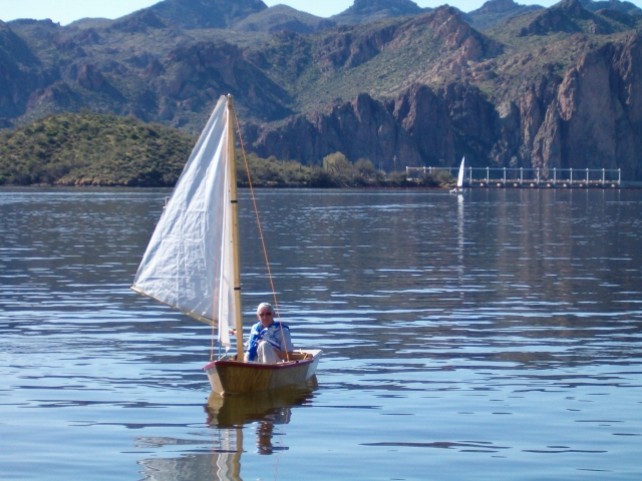
Light Wind Conditions on Lake Saguaro. Notice the other Sailboat in the background. It was under motor power at the time.
Follow Up
Yesterday was forecast to be windy. A storm was moving into the area and high winds were expected. This was my chance to test the limits of the TOTER 2 SAIL version. I got to the lake about 9 am and within 20 minutes had the boat all together with the sails up (main and jib). The wind was steady at about 5 to 10 mph. Perfect. It took a while to work things out, such as the new rope steering method, but I finally was under way and enjoying every moment. For about a half hour I was tacking from side to side, making my way to the other end of the lake. This was fun, and comfortable. But, before I could even think about it, a large gust nearly blew me over. Now I had to respond, by letting ot the main, in hopes that this was only a one time thing. As it turned, out the wind would increase in intensity for the remainder of the morning. I first lowered the Jib and stored it in the forward section, under the deck. Again, a large gust hit me and this time I took on some water over the center gunwale. Not much, but enough to make me realize that I must head back to the ramp, and perhaps call it a day. After a third huge gust I knew that the days sailing adventure was over, and lowered the main. Stored it up front also. Now I had to paddle back to the launch ramp, about a quarter mile away, heading into the wind. About 20 minutes later, and tired, I finally pulled the boat ashore, thankful that the sailing Gods were with me. Yes, I was wearing my PFD. I learned a few things this day. The boat was seaworthy, but not in gale force winds. Be vigilant at all times, for I nearly sailed into an anchored boat. And, heed the weather warnings. As a result, I am strongly recommending that the side sponsons be fabricated, and used, if you intend to sail in heavy wind conditions. They take only a few more minutes to assemble, and can easily prevent a knockdown. Remember, Safety First !
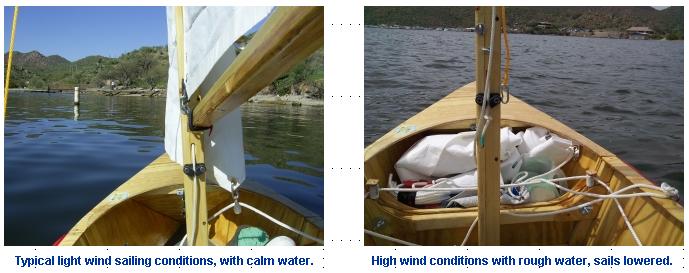
MANY
HAVE ASKED "WHERE IS THE KEEL?". This is a point of controversy.
Normally the question would be appropriate. However, let me make a
long story long. The original concept was for a portable boat that could
be fitted in almost any vehicle for transport. As a power boat that
posed no problem, and Toter 2 excels in that area, capable of carrying
two in tandem, with built in safety flotation chambers. But, I also
wanted to make this into a daysailer, and there was no way a daggerboard
could be utilized and still nest the hull sections. How about
leeboards? Well, possibly, but attaching them to the hull sides poses a
strength issue, especially if they were to be of the pivoting type,
necessary in shallow waters. Thinking outside the box early on, I
decided to provide removable sponsons that would add considerable
lateral buoyancy to the relatively narrow hull. The hull width (beam),
by the way, is well suited to the motorized version, as it is stable
with occupants seated, and yet has a decent length to width ratio,
necessary for easy passage through the water. The removable sponsons add
nearly 2 feet to the beam of the boat at mid section, making it a very
stable platform, and standing upright is no problem. The skids on the
hull and sponsons do provide a minimum of side resistance, and the hull
has a sharp chine, all helping to keep the boat in a straight line.
When
all these elements are applied to the small sailboat, the necessity for
a keel, or similar reactive object, is minimized. I have been out in
heavy winds without the sponsons, and did take on water a couple of
times. With the sponsons I am unable to list the boat much past the
sponson edge. Tests in high winds, over 25 mph, have not yet been
conducted, but I have confidence that the added buoyancy will make up
for the lack of a keel like appendage. Sailing into the wind will be
challenging at times, but that is a design compromise I have decided is
worth taking.
I
hope this long explanation is satisfactory for most peoples needs.
Pictures and a video of the sponsons are on this website, as are the
plans for downloading. Take a look, if you have not already, and see
what conclusion you come to. I will post more info as it becomes
available. Many thanks for your continued interest in the Toter 2
series.
Regards,
Ken
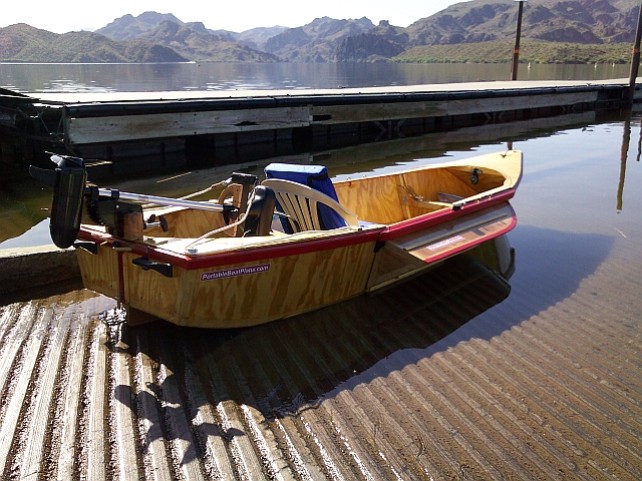
Download the Sponson Plans by clicking the link below. Allow the file to load, and then select Print or Save File.

|
SPONSONS.pdf Size : 0.872 Kb Type : pdf |










Aucun commentaire:
Enregistrer un commentaire